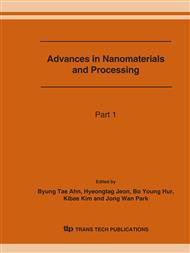[1]
Sang-Youl Kim, Yong-Su, Bo-Young Hur: Mater. Sci. Forum, Vol 510-511 (2006) 902-905.
Google Scholar
[2]
John Banhart, Progress in Materials Science, Vol 46 (2001) 559-632.
Google Scholar
[3]
G. Kaptay: Colloids and surfaces A: Physciochem. Eng. Aspects, Vol 230 (2004) 67-80.
Google Scholar
[4]
M.A. Shafi, R.W. Flumerfelt: Chemical Engineering Science, Vol 52 (1997) 627-633.
Google Scholar
[5]
J. Moller, K.I. Jacob, J. Schmelzer: J. Phys. Chem. Solids, Vol 59 (1998) 1097-1103.
Google Scholar
[6]
A. Dutta, A. Chengara, A.D. Nikolov, D.T. Wasan, K. Chen, B. Campbell: Journal of Food Engineering, Vol 62 (2004) 177-184.
DOI: 10.1016/s0260-8774(03)00230-9
Google Scholar
[7]
S. A. Magrabi, B.Z. Dlugogorski, G.J. Jameson: Chemical Engineering Science, Vol 54 (1999) 4007-4022.
DOI: 10.1016/s0009-2509(99)00098-6
Google Scholar
[8]
Liqun Ma, Zhenlun Song: Scripta Materialia, Vol. 39 (1998) 1523-1528.
Google Scholar
[9]
Zhen-lun Song, Jin-song Zhu, Li-qun Ma and De-ping He: Materials Science and Engineering A, Vol 298 (2001) 137-143.
Google Scholar
[10]
Hiroshi Arai: Transactions of JIM, Vol 27 (1986) p.151.
Google Scholar
[11]
Sang-Youl, Yong-Su Um, Bo-Young Hur: Trends in Metals & Materials Engineering, Vol 17 (2004) 37-46.
Google Scholar
[12]
L.M. Lifshitz, V.V. Slyozov: J. Phys. Chem. Solids, Vol 19 (1961) p.35.
Google Scholar
[13]
C. Wagner, Z. Elektrochem., Vol 65 (1961) p.581.
Google Scholar
[14]
Soo-Han Park, Yong-Su Um, Chang-Hoon Keum, Bo-Yong Hur: Colloids and Surfaces A: Physicochem, Eng. Aspects, Vol 263 (2005) 280-283.
Google Scholar
[15]
G.A. Young JR, J.R. Scully: Acta. Mater. Vol 46 (1998) p.6337.
Google Scholar
[16]
M. Ichimura, M. Imabayashi, M. Hayakawa: J. Japan Inst. Metals, Vol 43 (1979) p.876.
Google Scholar
[17]
Chin-Chen Yang, Chin-Tong Kawng, Kao-Chang Su: Imono (in Japanese), Vol 67 (1995) p.253.
Google Scholar
[18]
C.C. Yang, H. Nakae: Journal of Materials Processing Technology, Vol 141 (2003) 202-206.
Google Scholar


